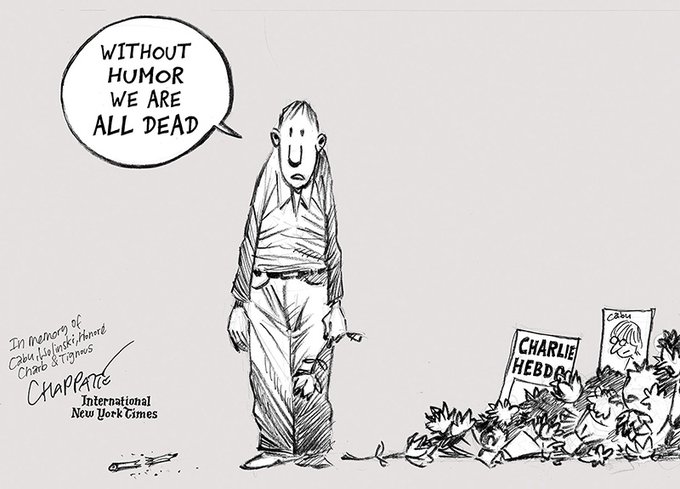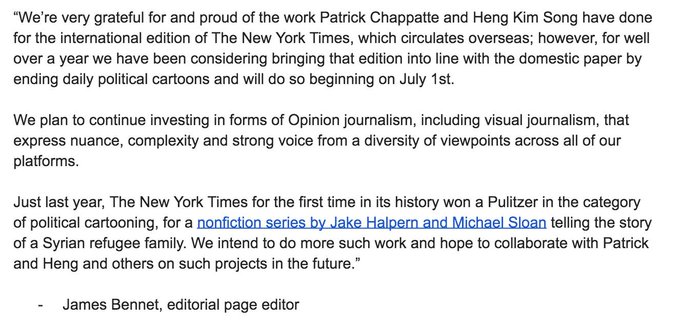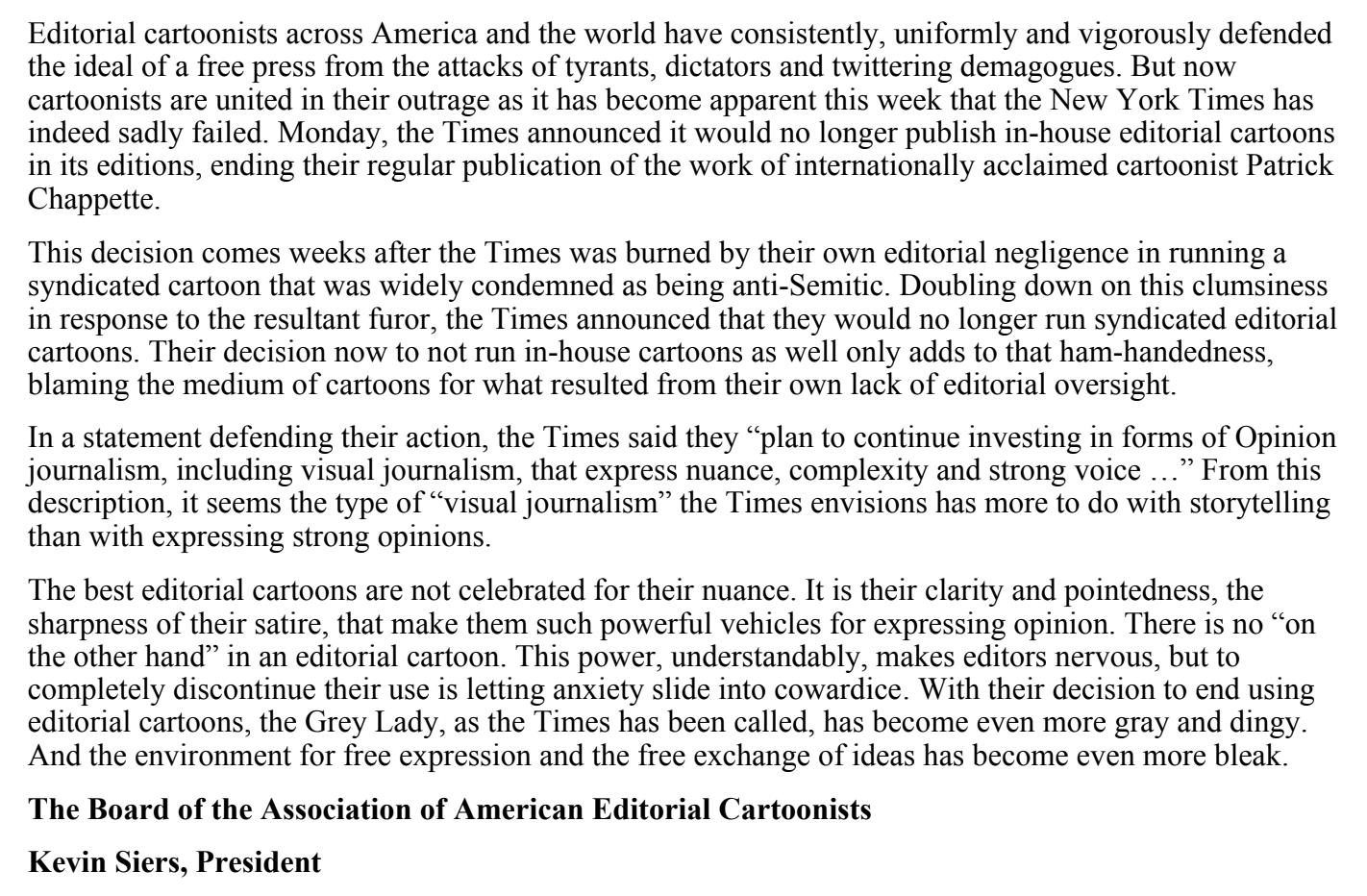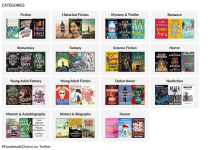In the wake of a social media outcry about an anti-Semitic cartoon featuring Benjamin Netanyahu published in its international edition, the New York Times has ceased running any political cartoons at all.
The news was first broken by cartoonist Patrick Chappette, who was angry and disappointed at the move.
In 20-plus years of delivering a twice-weekly cartoon for the International Herald Tribune first, and then The New York Times, and after receiving three OPC awards in that category, I thought the case for political cartoons had been made (in a newspaper that was notoriously reluctant to the form in past history.) But something happened. In April 2019, a Netanyahu caricature from syndication reprinted in the international editions triggered widespread outrage, a Times apology and the termination of syndicated cartoons. Last week, my employers told me they’ll be ending in-house political cartoons as well by July. I’m putting down my pen, with a sigh: that’s a lot of years of work undone by a single cartoon – not even mine – that should never have run in the best newspaper of the world.
I’m afraid this is not just about cartoons, but about journalism and opinion in general. We are in a world where moralistic mobs gather on social media and rise like a storm, falling upon newsrooms in an overwhelming blow. This requires immediate counter-measures by publishers, leaving no room for ponderation or meaningful discussions. Twitter is a place for furor, not debate. The most outraged voices tend to define the conversation, and the angry crowd follows in.
The Times released a statement regarding the move in a tweet, stating that “We plan to continue investing in forms of Opinion journalism, including visual journalism, that express nuance, complexity and strong voice from a diversity of viewpoints across all of our platforms.”
https://twitter.com/NYTimesPR/status/1138210949461159936/
The Times has not had editorial cartoons in its US edition – a break from most newspapers of its era – but had been running them in their international edition. However that ended when the inappropriate Netanyahu cartoon from a syndicated cartoon bank was published. The editor who let it go throughwas disciplined and the Times vowed to only work with its own cartoonists – such as Chapette – but even that was deemed too risky.
The Times has never been particularly cartoon friendly, but still the move came amidst declining work opportunities for editorial cartoonists around the country, due to shrinking newspapers, despite the powerful and honored heritage of cartoonists from R.F. Outcault to Pat Oliphant and today’s sharpest pens.
And cartoonists took to twitter to decry the move, including a statement from Kevin Siers, president of the Association of American Editorial Cartoonists.
Everyone from Ann Telnaes to Jen Sorenson also spoke out.
This is the response the NY Times gave when I explained I was cancelling my subscription because they dropped all editorial cartoons. pic.twitter.com/hchL6Sz23m
— Ann Telnaes (@AnnTelnaes) June 10, 2019
Journalistically tragic, and in sharp contrast to the @PostOpinions which employs two multiple award winning political cartoonists, @AnnTelnaes and @TomTolesToons https://t.co/3naDa34dfr
— Dave Swenson (@daswenson) June 10, 2019
NY Times prints one awful cartoon & now decides to stop running cartoons. By this logic, the paper should have shut down after its 2002-2003 WMD reporting. https://t.co/dJUYfElAE7
— Jeet Heer (@HeerJeet) June 10, 2019
When the NYT publishes a story or a photo that they later have to apologize for, they don't just END all photos and stories! This is a despicable response from a newspaper that won a Pulitzer last year for editorial cartooning. #cartoons #satire #NYTimes https://t.co/ciuaNskopz
— Rob Rogers (@Rob_Rogers) June 11, 2019
When the NYT publishes a story or a photo that they later have to apologize for, they don't just END all photos and stories! This is a despicable response from a newspaper that won a Pulitzer last year for editorial cartooning. #cartoons #satire #NYTimes https://t.co/ciuaNskopz
— Rob Rogers (@Rob_Rogers) June 11, 2019
Since the days of Nast nothing can pierce in public discourse like a powerful editorial cartoon. The NY Times decision to fire @PatChappatte and eliminate cartoons altogether (for a cartoon he didn’t even draw!) is a cowardly display of pandering to their critics. https://t.co/QPPLXRmNyw
— Adam Zyglis (@adamzyglis) June 11, 2019
By this standard of blaming an entire medium for an editing failure, the NYT should have no columnists left. https://t.co/tsLjlrRFgv
— Jen Sorensen (@JenSorensen) June 10, 2019
The Times has in recent years been running longer comics as part of multi media visual projects – last year “Welcome to the New World” a “graphic novel” about the Syrian Refugee crisis won a Pulitzer Prize. So they would seem to have incentive to understand the power of the word and image.
While many alternative venues for editorial cartooning – such as The NibThe Nib – have sprung up in recent years, the power of the Times as a platform can’t be underestimated, and giving up on editorial cartoons entirely seems like an odd move.










left wing cartoonists stabbed in the back by left wing newspaper, that’s quite amusing.
I recall when Boss Tweed was deep sixed by editorial cartoons. I also recalled how the World of Lily Wong ended. Then again I stopped reading Non-Sequitor it became a daily attack on anything that wasn’t/isn’t liberal/progressive and positing anything pro-conservative in the comments section was putting a target on your chest. Hate becomes predictable after a while and in the age we live in you can’t separate the hate from politics. This might go with the Times not letting their reporters appear on some of the cable news shows. With a presidential election upcoming the Times may be working hard to appear to be an unbiased news source.
Heidi, the cartoon was not anti-semitic.
The cartoon purpose was to point the finger at two specific people – Trump blindly following Netanyahu. Even if it’s not a black and white situation, it seemed like a valid point to make. The chosen way to do it was to use the metaphor of a blind man with a guide dog. Again, seems like an appropriate metaphor for the situation.
All the elements of the cartoon contribute to the representation of this very specific criticism of Trump. Blind man metaphor: dog, leash, glasses. Trump being or pretending to be a friend of Israel: kippa. And, as Netanyahu is not so universally identifiable as: Star of David.
Can the cartoon be interpreted as anti-semitic? Sure it can, as any cartoon criticising Netanyahu or Israel can. As any cartoon criticising Trump can be considered anti-american. Are those interpretations rational and logical? I don’t think so, they are knee-jerk and emotional. As I said, the cartoon is very specific. It presents no implications like “Netanyahu behaviour = Israel behaviour” or a “Netanyahu behaviour = jewish behaviour” or a “Trump behaviour = USA behaviour”.
Here’s a more articulate argument than mine: https://www.haaretz.com/opinion/.premium-that-netanyahu-cartoon-wasn-t-anti-semitic-1.7173253
Does nobody post here anymore but right-wingers?
Is this the sort of article that would attract those on the right?
I meant to type ‘isn’t’, not ‘is’. sorry
The point is of those evil right-wingers is that in a diverse egalitarian society where one person loudly declaring something offensive makes it equivalent to 10 people doing so, any activity that may be potentially offensive by its nature will be discouraged and that includes editorial cartoons. The list of things that one is not allowed to criticize or belittle keeps growing larger and larger. That does not bode well for anything that is remotely intellectual in nature.
It’s no surprise that it’s women that generally support less freedom of expression. Women were the Christian Right’s foot soldiers during their heyday. Contrary to claims by pundits on the Left, society tends to listen to women who feel offended.
I don’t know about you but I don’t trust the continuation of the American experiment in the hand of overly agreeable, consensus builders.
… AND GOYA WEPT OPENLY.
Comments are closed.